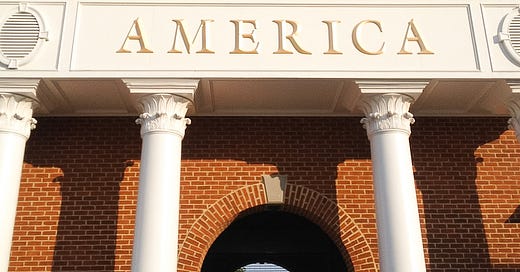Six Flags, One Nation, Under Demolition
Hated by locals, ignored by fans, and suddenly missed by everyone.
The park called itself America. Then it did what America does best: collapse under its own branding.
Six Flags America is (soon to be was) a theme park named for a country that couldn’t keep its own promises, and became a patriotic gesture turned punchline on the outskirts of D.C.
Originally launched in 1974 as Wild World, it rode the same postwar wave that birthed Disneyland clones and regional amusement parks from coast to coast. Americans wanted fun and the ‘70s would deliver.
By the time it was rebranded as Six Flags America in the late ’90s, the name felt like the perfect fit. Destiny. A park called America, ten miles from the Capitol, promising 100-proof patriotism with every coaster. Red, white, and mid-tier. Star spangled banners and… offbeat superheroes?
Six Flags America was never the best — but it was never supposed to be. It was the Applebee’s of amusement parks. A park you didn’t fly in for, but grew up next to. It gave you Roar, Joker’s Jinx, and other coasters that rattled just hard enough to make you question your ear piercings (hello, SLC).
It should’ve thrived. Positioned near one of the wealthiest and most tourist-trafficked metros in the country, it had every advantage. But like its namesake, it ran on aging infrastructure, conflicting narratives, and inadequate attention stifling progress.
So, what killed Six Flags America? The same thing that kills everything these days — corporate neglect and monopolistic mergers.
But this time, they learned from their history. Sort of. Ish.
After the off-season bloodbath, when coasters – lovingly loathed and fervently adored alike – were yanked into oblivion without notice, Six Flags did something novel: they told the public. An actual announcement. And in advance at that.
“As part of our comprehensive review of our park portfolio, we have determined that Six Flags America and Hurricane Harbor are not a strategic fit with the company’s long-term growth plan. After reviewing a number of options, we believe that marketing the property for redevelopment will generate the highest value and return on investment.”
In layman's terms: after years of ignoring this small fish in favor of our golden child headliners, we realized the park’s land is ten times more valuable than the park itself.
And so, November 2nd — a date already tattooed into the American subconscious by Election Day cycles — will now mark the final day of Six Flags America. Demolition ballots cast by the boardroom.
For now, the clock ticks on a land built to amuse its citizens while quietly extracting everything from them. True Americana.
There won’t be a protest or a sit-in. Just another summer of parents taking full advantage of a $35 babysitter before the daycare goes out of business come autumn. Where the rest of the locals continue to ignore the park’s presence, if they have yet remembered that it's there at all, while miffed coaster enthusiasts – genuinely and personally put off by the park's impending removal – descend upon Six Flags America for their very first time.
It’s the most attention the park has gotten in its entire existence. Sponsored by retrospective FOMO, sudden sentiment syndrome, legacy panic. All overshadowed by a vocal majority chorusing, “Good riddance!”
While the bones remain for a few months to come, the park named for America is long gone.
Six flags, one nation, under demolition.






